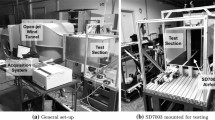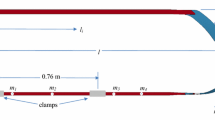Abstract
In this study, the flight performance of four models of shuttlecocks, two with feather skirts and two with plastic, is investigated. The aerodynamic forces of each shuttlecock at varying air speed and angle of attack are measured in a subsonic wind tunnel. Empirical correlations derived from these data are then incorporated into an adaptive, shuttlecock-specific numerical trajectory simulation. These simulated trajectories are in good agreement with experimental results, with average and maximum errors of 2.5 and 9.1% in vertical distance travelled. The aerodynamically adaptive trajectory model is used to analyse four common types of badminton shot: serve, net, smash and high clear. From these simulations, it is found that the trajectory paths of the higher quality plastic shuttlecock most closely mimic those of the feather shuttlecock of same speed grade. Results of both aerodynamic testing and trajectory simulation provide quantitative support for players’ preference for the ‘feel’ and responsiveness of feather shuttlecocks. It is also observed that plastic shuttlecocks fly faster than do feather shuttlecocks under smash shots, a behaviour explained by a reduction of drag due to skirt deformation observed in wind tunnel experiments at high flight velocity. The results of the study highlight the influence of shuttlecock design and material on shuttlecock flight.














Similar content being viewed by others
References
Lowell AL (1916) A Roxbury garden. In: Men, Women and Ghosts. The MacMillan Company, New York
Kwan M, Cheng CL, Tang WT, Rasmussen J (2010) Measurement of badminton racket deflection during a stroke. Sports Eng 12:143–153
Cooke A (1999) Shuttlecock aerodynamics. Sports Eng 2:85–96
Cooke A, Mullins J (2007) The flight of the shuttlecock. New Scientist 1916:40–42
Lambert C (2010) Badminton’s lightning charm. Harv Mag 57–59
Alam F, Chowdhury H, Theppadungporn C, Subic A (2010) Measurements of aerodynamic properties of badminton shuttlecocks. Procedia Eng 2:2487–2492
Cooke A (2002) Computer simulation of shuttlecock trajectories. Sports Eng 5:93–105
Chen LM, Pan YH, Chen YJ (2009) A study of shuttlecock’s trajectory in badminton. J Sports Sci Med 8:657–662
Peastrel M, Lynch R, Angelo A (1980) Terminal velocity of a shuttlecock in vertical fall. Am J Phys 48(7):511–513
Post SL, McLachlan J, Lonas T, Dancs J, Knobloch D, Darrow C et al (2009) Aerodynamics of a badminton shuttlecock. In: ASME 2009 International Mechanical Engineering Congress and Exposition. ASME, Lake Buena, pp 1–6
Mehta RD (1985) Aerodynamics of Sport Balls. Annu Rev Inc 17:151–189
Tsai CL, Huang CF, Jih SC (1997) Biomechanical analysis of four different badminton forehand overhead strokes. Phys Educ J 22:189–200
Chang SS (2002) Kinematic analysis via three-dimensional cinematography for two types of forehand smash stroke in senior high school badminton players. Masters thesis, National Taiwan Normal University, Taiwan
Watts RG, Ferrer R (1987) The lateral force on spinning sphere: aerodynamics of a curveball. Am J Phys 55(1):40–44
Stevens D (2008) Forum discussion Badmintoncentral.com. Accessed 10 Sept 2010
Davies JM (1949) The aerodynamics of golf balls. J Appl Phys 20:821–828
Acknowledgments
The authors are grateful to Lafayette College Mechanical Engineering Department, which provided support for the completion of this work as the first author’s undergraduate honours thesis. They are particularly indebted to Keith Moon and Harry Folk. Support for instrumentation used in the current study was provided by the National Science Foundation (CTS 0552104).
Author information
Authors and Affiliations
Corresponding author
Rights and permissions
About this article
Cite this article
Chan, C.M., Rossmann, J.S. Badminton shuttlecock aerodynamics: synthesizing experiment and theory. Sports Eng 15, 61–71 (2012). https://doi.org/10.1007/s12283-012-0086-7
Published:
Issue Date:
DOI: https://doi.org/10.1007/s12283-012-0086-7




